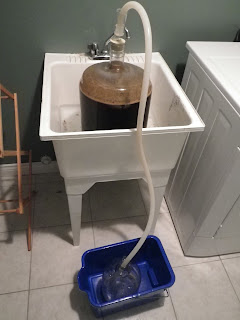 In late February/early March of 2009, my wife and I went on a week-long trip to Belgium. Anything positive you have heard about this country is completely true, and, of course, the beer is outstanding. It was this trip that triggered my love of beer, and ultimately led to my passion/infatuation with brewing. While I have a lot of Belgium-beer moments in my memory, one of the clearest is when I had my first Duvel (pronounced DOO-vel, not Doo-VELLE) at a small beer bar in Bruges. Few would argue against it being THE penultimate Belgian Golden Strong Ale; in fact, it seems like Duvel actually STARTED the style.
In late February/early March of 2009, my wife and I went on a week-long trip to Belgium. Anything positive you have heard about this country is completely true, and, of course, the beer is outstanding. It was this trip that triggered my love of beer, and ultimately led to my passion/infatuation with brewing. While I have a lot of Belgium-beer moments in my memory, one of the clearest is when I had my first Duvel (pronounced DOO-vel, not Doo-VELLE) at a small beer bar in Bruges. Few would argue against it being THE penultimate Belgian Golden Strong Ale; in fact, it seems like Duvel actually STARTED the style.I've tried several BGS ales since having my first Duvel, and while some have been quite impressive (such as Russian River's Damnation), most fall far short of the one that started it all. A bit spicey, with some fruity esters (especially pear, which helps distinguish it apart from others), it finishes moderately bitter, and bone dry. VERY carbonated, the beer supports a huge, long-lasting white head. The alcohol is amazingly deceptive, hence the name... most BGS ales have some form of the word "Devil" in their name.
I don't know why it took me so long to get around to brewing a Belgian Golden Strong myself, but in September I finally did, using the recipe from Brewing Classic Styles. Probably one of the simplest recipes (at least in terms of the grist and hop schedule) I've ever done, the real aspect that makes it stand out is the yeast. I went with Wyeast 1388 Belgian Strong Ale, which is similar to that used by the Duvel Moortgat brewery, providing that pear aroma/flavor that you look for in Duvel. The amount of table sugar may seem high, but you need it to dry the beer out and boost the alcohol level. The recipe called for the fermentation temperature to be raised gradually, to as high as 80 F... much higher than you'd normally use, but a lot of Belgian beer styles call for warm fermentations, to help bring out the spicey and fruity characters of the beers. Now that the beer has had a few months to mature in the bottle, I find it's really turned out quite well, and surprisingly close to Duvel itself.
Appearance: Poured with a large, white head that hangs around for quite awhile before finally fading to 1/2-finger. Body is a light yellow (the picture doesn't have enough light to show this), with excellent clarity. Bubbles jetting up to the top from the center bottom of the glass.
Aroma: Aroma is fruity (apples and pears), with a background of phenolic spiciness. There is a hint of alcohol in the aroma as well.
Taste: Fruity and spicy... nice. I’d say the apple/pear flavor comes through first, followed by some spiciness and a very dry, moderately bitter finish.
Mouthfeel: Light-bodied, high carbonation. A bit prickly on the tongue as a result. A bit of alcohol warmth, but quite deceiving (as the style calls for).
Overall: I think I’m pretty happy with this beer... definitely improved over even a few weeks ago, especially in terms of the appearance (originally was a bit hazy, and the head dropped almost immediately).
Recipe (5.5 gallons, 80% efficiency): OG 1.075, FG 1.009, IBU 32.5, SRM 3.4
Grains/Adjuncts:
4.2 kg Bohemian Pilsner malt
1.36 kg table sugar
Hops:
1. Saaz - 63 g (4.5% AA) @ 90 min
Misc.:
1/2 tsp yeast nutrient @ 15 min
1 tab Irish Moss @ 15 min
Yeast: Wyeast 1388 Belgian Strong Ale (PD Aug 15) (with a 1 L starter)
- Brewed Sept.12/11 by myself. 75-minute mash with 13.88 L of strike water, mashing in at 149 F. Sparged with 6 gallons of 168 F water for final volume of 7.25 gallons in the kettle. Both strike and sparge water treated with 1/4 tablet of Campden. 90 minute boil.
- Chilled down to 67 F with copper immersion chiller. OG a bit high, 1.050 (original recipe called for 1.047 before sugar addition). Pitched yeast, aerated by shaking for several minutes before and after.
- Fermentation started by the next day. Temps in the low 70s. After a couple of days, when fermentation started to visibly slow, I added 454 g of table sugar each day for 3 days. You can add the sugar during the boil, but this way the yeast gets used to breaking down more complex sugars that glucose before having the "dessert" of the table sugar, and it also means a smaller yeast starter is needed when pitching the yeast.
- Temp got as high as 78 F during active fermentation. Bottled after ~4 weeks in primary with 235 g table sugar, aiming for 4 vol CO2 for 5 gallons. Bottled 10 x 500 mL, 41 x 12 oz. Left in room at ~72 F for 2 weeks to carbonate.




